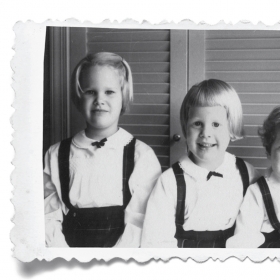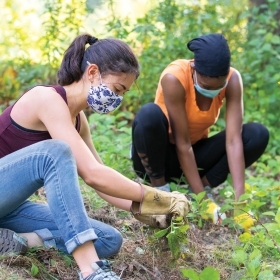In the middle of the lockdown in April, my sister sent me some outtakes she had found from those long-ago family Christmas shots—bad haircuts, pouting, tears, and all. I hadn’t laughed so hard in a long time. Who would have thought that decades later, those pictures would have brought much-needed cheer during a pandemic?

The Hummer sisters in an early holiday photo. The future Wellesley magazine editor is in the center.
If you’re old enough, think back to the days before cell-phone and digital cameras were as ubiquitous as, say, face masks. (If you’re not, humor me and imagine.) When I was growing up, my mother shot our annual holiday pictures with an ancient camera that hung around her neck. She peered down into the pop-up viewfinder and tried to focus while coaxing three squirming little girls in matching outfits to sit still. Invariably, one of us ended up in tears. When I was of an age to have my own camera—like the tiny Olympus I took to Moscow when I went off to study Russian in college—I learned the satisfaction of preserving what I was seeing for time immemorial (or so it seemed to my 20-year-old self). Of course, there were only 36 exposures on a roll of film, and you had to be darn sure not to waste them before you saw that perfect gold onion dome glinting in the rosy sunset.
All those years ago, as a child subject or a budding photographer, taking pictures seemed really complicated. And so it seems today in this pandemic era. In recent issues, you may have noticed more than the usual number of illustrated portraits. Why? Sometimes, our subjects have been taking classes remotely from the other side of the world, or in the case of an administrator we profiled recently, she was working round-the-clock helping faculty transition to Zoom teaching and just couldn’t step away to have her picture taken. We have shot some photos this summer and fall (our cover, for example, and the faculty portraits of professors Petra Rivera-Rideau and Josh Lambert), but almost always outside, always with long lenses to maintain social distancing, and always with us masked. Even coming to campus from our remote workspaces requires clearance, because of necessary safety protocols. It’s complicated, and you will see us continuing to ad lib, particularly as the weather gets colder and it’s harder to shoot outside.
And now a word about the photos in class notes. Many of you love them, and we are braced for a collective wail when you see none in this issue. (Wait! Find them in the online class notes columns.) Why? First, we are receiving fewer photo submissions, as the happy gatherings where they are often taken—weddings, mini-reunions, trips—are just not happening as frequently right now. Second, all of the measures taken by the College to keep students safe on campus (see the “Window on Wellesley” section for details) have cost millions. As part of campus-wide cost-saving measures, we are cutting eight pages from the magazine, and publishing notes photos online is one of many ways we are saving space. We hope to return to our normal photo practices when the pandemic is past.
In the middle of the lockdown in April, my sister sent me some outtakes she had found from those long-ago family Christmas shots—bad haircuts, pouting, tears, and all. I hadn’t laughed so hard in a long time. Who would have thought that decades later, those pictures would have brought much-needed cheer during a pandemic? So keep taking photos. Snap some shots of your kid happily covered with flour after making sourdough, even if she just threw a hissy fit and refused to attend the day’s online classes. Save those screen shots of you and your College buddies hanging out on Zoom, sipping quarantinis. And if you’re fortunate enough to be somewhere you can have a heart-to-heart with your Wellesley roommate in person—six feet away and in masks, of course—record it with your phone’s camera. Because decades hence, we’ll need these shots for the historical record—and to help us remember the bonds of love that got us through.


